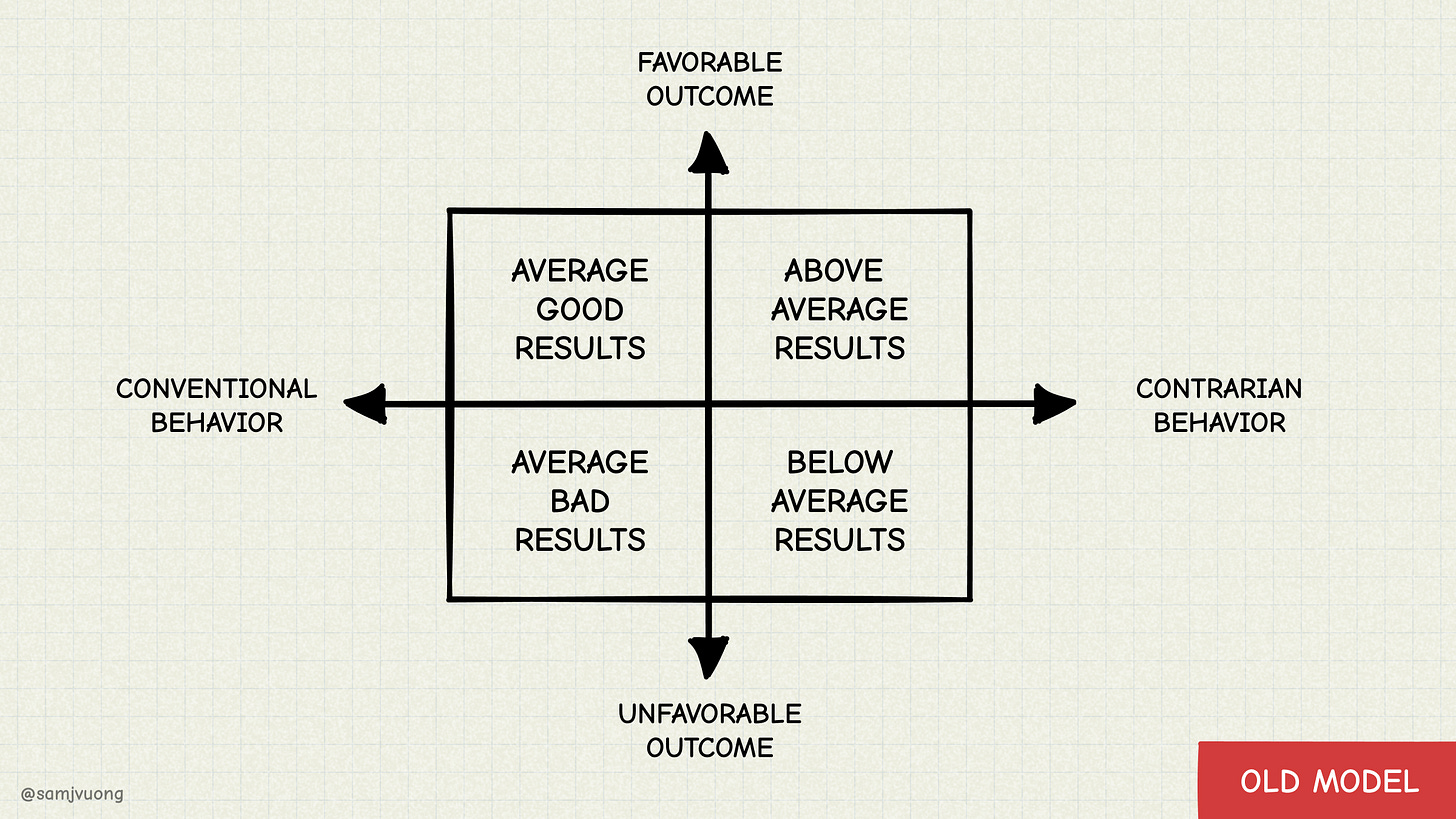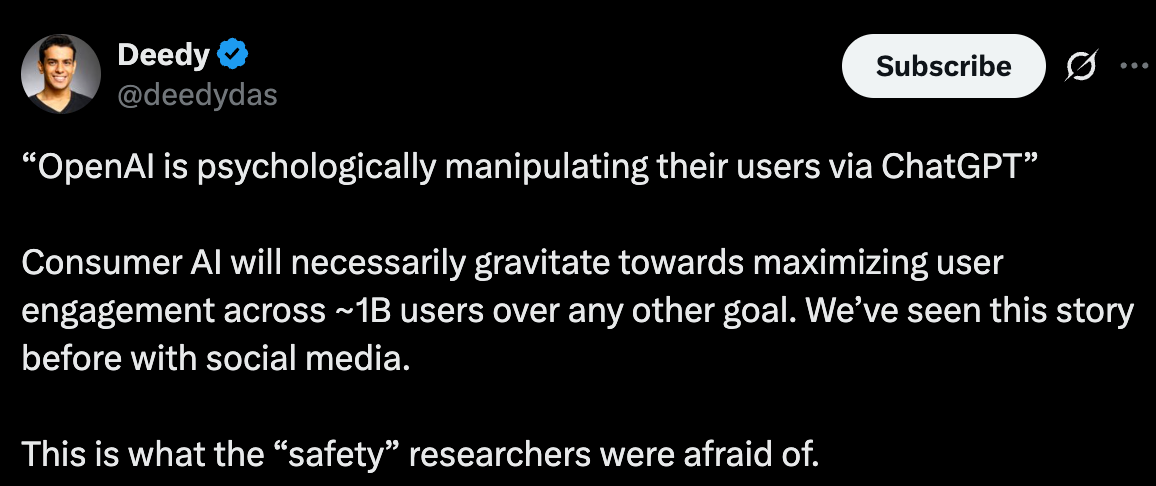Contrarianism is the new alpha
How to think (and raise kids) differently in a conformist world
“The crowd is untruth.” — Søren Kierkegaard
Being a contrarian isn’t cool, until it is. It’s human nature to conform to the tribe.
And while some of the greatest contributors of our time were contrarians themselves, mainstream society has mostly operated on the handshake-deal understanding: work really hard → follow the rules → win the game.
But this formula no longer guarantees success. As
, Co-Founder & CEO of Spellbook, recently framed it, “There used to be ambient alpha available to anyone with above average work ethic and courage. It was vacuumed up by machine leverage and capital leverage.”The old sources of leverage—hard work, credentials, timing—have been crowded out. A degree doesn’t beget a job. Being a dropout is becoming higher signal to the market in some industries.
Conforming used to feel safe. In a Red Queen world, it’s how you get left behind.
More than ever, original thinkers and outsiders hold disproportionate leverage. The ability to see beyond the system, build in niche spaces, and act on conviction is where the alpha lives. That’s how you stand out.
But schools aren’t built for that. They can’t train students to be contrarian when they’re designed to optimize for mass participation.
Opting out is the entry point to alpha. That’s why parallel systems like alternative education are starting to gain traction.
Those closest to the shifts already know this is the new way to get ahead.
Contrarian thinking isn’t natural, but it’s essential
Going against the grain is difficult, and neuroscience confirms this:
An fMRI study found that resisting peer opinion triggers increased activity in the amygdala, the part of our brain associated with fear and emotional salience.
It’s not just emotional friction, it’s cognitive, too. We’ve moved from predictable, “kind” learning environments to messy, fast-moving “wicked” ones.
In the old model, a kind learning environment meant conventional behavior yielded average outcomes both good and bad. Contrarian behavior, on the other hand, had more variance, with higher upside but more downside.
The risk was higher to go against the grain, and so contrarian behavior was a gamble few were incentivized to take.
But that’s flipped. In today’s environment, playing it safe has its own risks. Conventional paths now come with diminishing returns and eroding relevance.
The rules of the New Model are unclear, feedback is delayed or distorted, and the game keeps changing. In other words: systems where consensus thinking fails and outsiders, guided by independent thought and conviction, thrive.
Contrarian thinking, not blind rejection of the status quo, is about seeing something others missed and acting on it. That mindset is deliberately cultivated by those who dominate today’s success narrative: investors, founders, and creators.
Example: Homeschooling as a contrarian bet. While it’s becoming more popular, the decision to homeschool is still not the norm, public school is.
Note: This isn’t a blanket endorsement, just an illustrative example.
Conventional choice: Public school.
Still the default for most families.
Favorable outcome: Your child performs well and moves through the standard pipeline. But even strong outcomes now yield less. Degrees are oversupplied, and institutional success doesn’t map cleanly to real-world readiness.
Unfavorable outcome: Your child falls behind or disengages. Because you followed the norm, you’re insulated from scrutiny - misery loves company. But you still face the cost: a young adult who can’t find direction, work, or independence.
Contrarian choice: Homeschooling.
A direct challenge to the system’s value proposition.
Favorable outcome: More tailored learning. Stronger independence. The potential for a better fit in a world that no longer rewards sameness.
Unfavorable outcome: Outcomes are more visible. The burden of proof is on you for taking this bet. If it fails, there’s no one to defer to.
Conventional choices now offer limited upside with hidden risk. The contrarian path carries more exposure, but it’s where the real leverage lives. There’s no guaranteed path for success in a wicked environment, including passively accepting the status quo.
The need to think critically and interrogate assumptions will only become more powerful in the age of AI, where mainstream LLMs pander to mass psychology through glazing and overly flattering responses leading to confirmation bias.
As an extension of disinformation in the media, our lives will increasingly depend on LLMs that can distort and deceive through more pernicious manifestations. We need to be equipped to resist passively accepting everything we're told.
Three mental models that fuel contrarian thinking
First-principles thinking: question assumptions and break things down to fundamentals instead of copying existing models.
e.g. a parent questioning the 8-hour school day and opting instead to build a flexible learning schedule based on their child’s focus patterns and interests.
Inversion: start by imagining what failure would look like, then work backward. It’s easier to avoid known traps than predict the perfect move.
e.g. someone choosing to rent instead of buying a home and taking on a mortgage because they want to live a more volatility-resistant life.
Third-order thinking: zoom out to ask what system am I reinforcing by making this decision?
e.g. turning down a promotion, not because it’s bad now, but because it locks you into a system you no longer want to operate in.
Raising the next generation of contrarians
Contrarian thinking is difficult to teach in systems designed for mass participation.
Public schools may encourage critical thinking in principle, but the structure of the system (standardized testing, large class sizes, and age-based conformity) rewards compliance over originality.
That doesn’t mean contrarian thinking can’t be taught. But it’s an uphill battle.
In a school of hundreds, fitting in feels essential. Questioning the “right answer” becomes riskier when that answer is what earns the grade.
By contrast, some alternative models are better predisposed to cultivate contrarian thinking:
Socratic Method
Uses structured dialogue to develop clarity of thought. Students learn to question ideas, challenge assumptions, and revise their thinking in real time.
The Socratic Experience founded by
, centers Socratic intellectual inquiry as the foundation of learning. Through daily Socratic seminars, students are challenged to question deeply, reason clearly, and develop their own perspectives. It’s one of the few schools where independent thinking is designed from the ground up.
Project-Based Learning
Centers learning on real-world problems that don’t have clear answers. Students make decisions, test ideas, and learn by doing. Contrarian thinking becomes part of the process.
High Tech High is one of the most established PBL models, where long-term interdisciplinary projects push students to lead, build, and present their work in public exhibitions.
Montessori
Encourages students to choose their own work and pace, helping them build confidence in their judgment early. Autonomy is built into the structure of learning. I write more about this here.
Even if you’re not fully embracing these models, the mindset can be brought home.
Two ways to start:
Model disagreement well. Let your child overhear thoughtful disagreement between you and a partner, a podcast guest, or a character in a book. Show them that conflict and failure is a normal process in ideating and questioning assumptions.
Create stakes for decision-making. Give your child a real responsibility like planning the weekend or budgeting for a project and let them feel the outcomes of their choices. Alexis Ohanian recently shared that his daughter earns her allowance through a chore contract, negotiated with Serena acting as her lawyer. It’s a playful but deliberate way to build ownership and decision-making muscles early.
Raising a contrarian thinker means raising a child who’s comfortable standing alone. In a world of diminishing returns for doing what everyone else does, that’s the best advantage you can give them.
I think about this more now as I prepare myself for kids of my own. What kind of systems will they inherit? What will I subconsciously pass down if I’m not paying attention?
Koshu recently wrote a great piece on the evolution of business models, and entering the age of the Decision AI Era, where AI will offload decision making on our behalf.
"The logic of business is evolving—from serving human wants to anticipating them, then eventually overwriting them.
And so the question then isn't how much AI can do. It's how much we’re willing to delegate before we forget what it means to choose" -
Tech is moving at the speed of light. If we don’t deliberately preserve culture and shape the future ourselves, we risk stagnation and falling victim to algorithmic drift.
A profound reminder that we ought to continue questioning assumptions, and cultivate a bias for action both for ourselves and the future generation.







Build contrarian culture by practicing more art and creative endeavors. As an artist you are forced to think outside the box in order to survive and thrive. If you aren't constantly innovating or creating something novel and unique it's just a master study of someone else and you are just a copycat. In order to be a successful artist or creator you must think of something new and novel otherwise the content you produce will be tired and get no praise. I may be biased but my childhood and young adulthood was mostly full of art and I truly believe it's why I am constantly questioning the status quo. Artists are also just naturally good at questioning things and not just taking them at face value.
Thank you for the mention, and looking forward to even more contrarian posts! :)